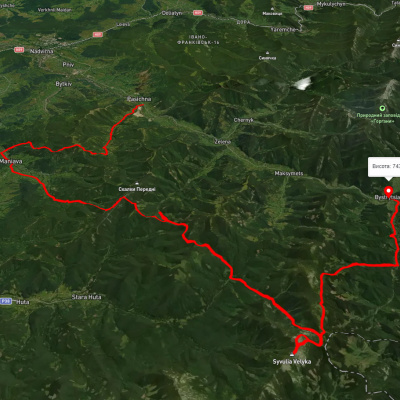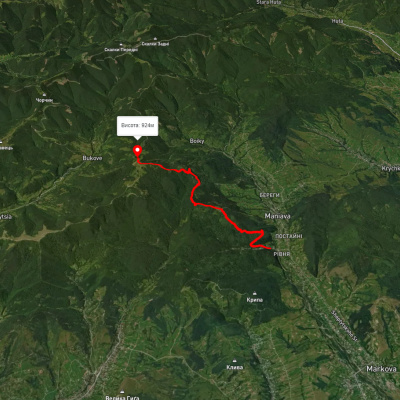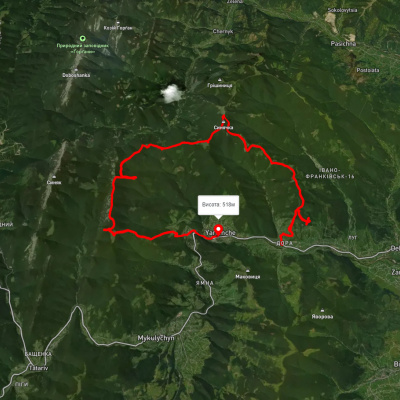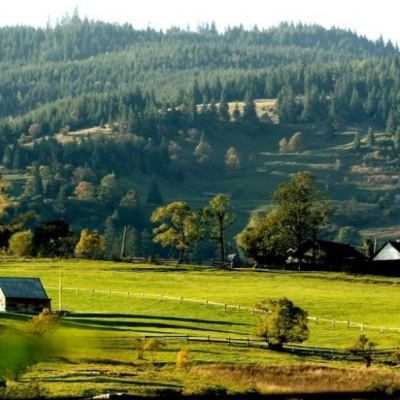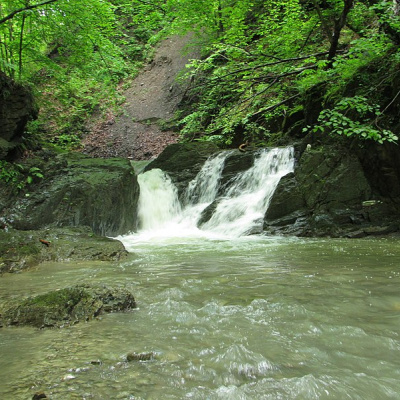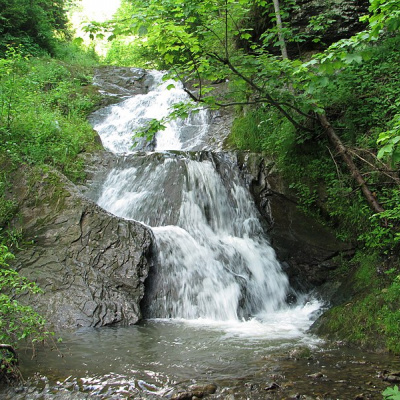Ivano-Frankivsk region
Ivano-Frankivsk region is located in western Ukraine; it borders Lviv region to the northwest, Ternopil region to the northeast, Chernivtsi region to the southeast, and Zakarpattia region to the southwest. In the south, it shares a border with Romania. The region was formed on December 4, 1939, and until 1962 was called Stanislavska. It is now divided into 14 districts. The region has 15 cities (including 6 of regional significance), 24 urban-type settlements, and 804 settlements. The regional center is the city of Ivano-Frankivsk (Stanislav until 1962). The Ivano-Frankivsk region is home to the Hutsul and Boyko ethnic groups, which also offer accommodation in their estates, cottages, apartments, and hotels.
The Ivano-Frankivsk region has opportunities for many types of tourism: cultural and historical(Halych, Kolomyia, Rohatyn, Ivano-Frankivsk), patriotic (tours of the UPA's places of military glory, museums, bunkers), rural green, skiing, horseback riding, water, adventure, etc. The region's natural recreational resources include a favorable climate, mineral waters, and therapeutic peat mud. The resorts include the lowland Yaremche, Tatariv, Mykulychyn, Myslivka, Novyi Mizun, Sheshory, the highland Vorokhta and Yablunytsia, and the balneo-mud foothill resort of Cherche. Mineral waters: in the mountainous part - sodium chloride(Verkhovyna and Rozhnyativ districts), along the Black Cheremosh - carbonate waters of low mineralization, near the village of Sheshory - water of the "Naftusya" type; in the Carpathian region - sodium chloride and calcium-sodium(Dolyna, Kalush, Starunya, Kosmach, Kosiv); in the plains - iodine-bromine of low mineralization and sulfide(Bilshivtsi, Korshiv, Horodenka, Cherche). Peat mud deposits are located in Horodenka, Rohatyn and Dolyna districts.
The region has a well-developed tourism and recreation industry. The key types of tourism are active (skiing and hiking) and recreational. While the mountainous part of the region is characterized by optimal conditions for winter tourism and recreation, the plain and foothill parts of the region are suitable for tourism and recreation in the warm season, and the microclimate of the resorts provides opportunities for recreation and health improvement throughout the calendar year. As Ivano-Frankivsk is the location of the convergence of highways and railways, the regional center is considered the tourist gateway to the Carpathians. All the major tourist centers in the region: Yaremche, Kosiv, Rozhnyativ, Verkhovyna, Dolyna, and even the Dniester Canyon area are approximately equidistant from Ivano-Frankivsk, at a distance of 80-100 km.
A significant part of the region lies within the physical and geographical zone of the Carpathians, while the extreme southeastern part is in the forest-steppe zone. The Ivano-Frankivsk region is divided into three parts by the nature of its relief. In the north, there is the Podillia Upland (up to 430 meters). Along the right bank of the Dniester, the Precarpathian Lowlands (Pokutske Lowlands, Voynylivska and Prylukvynska uplands, Bystrytska, Kalushska, and Rozhnyativska depressions, Maidanska Lowlands, etc.) Almost half of the region's territory is occupied by the Carpathians. They are divided by transverse and longitudinal valleys into mountain ranges and ridges of southeastern extent - the Gorgany and Pokutsko-Bukovyna Carpathians. In the south of the region there are the Hryniava Mountains, the Chyvchyn Mountains, and the Chornohora Range, where the highest point of Ukraine, Mount Hoverla (2061 m), is located.
There are 8586 rivers flowing through the region. They belong to the Dniester and Prut basins. Tributaries of the Dniester within the region: Svicha, Limnytsia, Lukva, Bystrytsia - right; Svir, Hnyla Lypa - left. Tributaries of the Prut: Cheremosh, Rybnitsa, Pistynka, Liuchka - right; Turka, Chorniava, Beleluia - left. The rivers are mostly fast-flowing, forming cascades and waterfalls, which is valuable for water tourism. There are few lakes, among the mountainous ones are Brebeneskul, Lebedyne, and Nesamovyte.
Ivano-Frankivsk region is one of the richest in forests in Ukraine. On the plains and in the foothills, they account for 30% of the territory (hornbeam, oak, and beech predominate), and on the slopes of the Carpathians - 60% (at an altitude of 800-1000 meters - beech, spruce or fir (dialect), white fir; up to 1500 meters - spruce, fir, cedar, and mountain pine). At altitudes above 1500 m, subalpine meadows (polonynas) begin.
Prykarpattia is a land of nature reserves. In total, there are 438 protected areas and objects with a total area of 186.5 thousand hectares in the region. A part of the mountainous area of 503 km2 is designated as the Carpathian National Nature Park. It covers the upper reaches of the Prut and Black Cheremosh rivers with Mount Hoverla - the Chornohora and Gorgan natural complexes. The park's mission is to promote the preservation of landscapes, flora and fauna, create appropriate conditions for recreation and tourism, and to explore natural resources, cultural and historical monuments.
The dynamic development of tourism in the Carpathians is ensured by the creation of a modern recreational infrastructure with a high level of service, which has become particularly popular in recent years. Tourists are offered rooms with satellite TV, bathrooms and showers, as well as saunas, sleeping bags, tents, ski equipment and bicycles for rent. Moreover, such services are provided both in large recreation facilities and in mini-hotels. Cycling, hiking, and horseback riding in the Carpathians, visiting unique natural sites and famous historical monuments, and rafting on mountain rivers or the plain Dniester are very popular among tourists. The ethnic music festival in the village of Sheshory and the biker rallies in Kosiv are widely known. Unfortunately, such a type of "sports recreation" as off-road car rallies in the mountainous part of the region has recently become very popular.
Snow cover in the Carpathians lasts from November to May, which is very important for the development of skiing. The largest and most modern ski resort in Ukraine, Bukovel, is located in the region. The resort has dozens of mansions and hotels, and many vacationers live in Yaremche, Vorokhta, or in the surrounding villages and come here for skiing. Bukovel has almost two dozen ski lifts, most of which are chairlifts. Another ski center known since Soviet times is the village of Vorokhta. It has artificially surfaced ski slopes that operate year-round.
For stationary recreation, the most popular are Verkhovyna, Kosiv, and Rozhnyativ districts, where green tourism is flourishing, with more than 400 hospitable rural inns offering their services. Almost all hotels in the Carpathians are located at the foot of the mountains near highways in areas that are famous for their healing climate. Important resorts in the mountainous part are Vorokhta, Kosiv, Yaremche, Sheshory, and there are also sanatoriums that treat various forms of tuberculosis, diseases of the nervous system and musculoskeletal system. The mud sanatorium in the village of Cherche has been known since ancient times and is still in operation.
The area of protected lands in Ivano-Frankivsk region covers 195,633 hectares, with the Gorgany Nature Reserve as the central environmental institution, as well as natural national parks and reserves. The Gorgany Nature Reserve was created to preserve relict pine species and subalpine landscapes, and it is home to plants listed in the Red Book of Ukraine. One of the largest natural parks in Ukraine is the Carpathian National Park, which is located in the highest sector of the Chornohora and Gorgany massifs. The highest point of Ukraine, Mount Hoverla, is located within the park's territory, and its alpine landscapes are home to a large number of relict species of Carpathian flora. The Galician National Park is designed to protect the diversity of natural complexes in the Carpathian region, and it has an interesting nature museum. More recently, in the 21st century, two more national parks were established in the region. The Hutsulshchyna National Park, founded in 2002, was created to protect natural complexes, flora and fauna within the Kosiv district, and is active in research, publishing books, and developing tourist and ecological routes. The park is home to ancient wooden churches of the Hutsul region, including the oldest church in the district, the Church of the Assumption in the village of Pistyn. In 2010, the Verkhovyna National Park was founded, focusing on the protection of the highland landscapes of the most remote, inaccessible and wild southern part of the region - the Chyvchynsko-Hryniavski Mountains, where the Cheremosh has its source.
Of course, the main natural attraction of the region is the mountains, forests, and rivers of the meadows. However, Ivano-Frankivsk region is home to many natural attractions that are considered to be a kind of symbol of the region. The complex natural monuments of national importance include the Dovbush Rocks in the village of Bubnyshche, Bolekhiv district, which stretch from east to west for almost a kilometer in the middle of spruce and beech forests. The giant rocks are unique and inimitable due to their location and pile of stones, which is why they attract thousands of tourists. The rocks resemble incredible creatures and are a favorite training place for climbers and mountaineers. The Dovbush Rocks are part of tourist and educational routes for vacationers in the resorts of Morshyn and Truskavets. Another iconic natural object is Mount Hoverla, which is located on the border of Ivano-Frankivsk and Zakarpattia regions, is the highest mountain in Ukraine, conical in shape, and has its source at the foot of the Prut River.
There are a number of beautiful waterfalls in the region. The highest of them is the Manyavsky Waterfall (Manyavka River, Bohorodchany district), which reaches a height of 22 meters and is located near the legendary monastery - Manyavsky Skyt. Social networks are full of "selfie" photos from the low but powerful Probiywaterfall, which was formed in a narrow Prut canyon within the city of Yaremche. Easily accessible and beautiful is the Zhenetskyi Huk waterfall near the village of Tatariv. A unique attraction is the Starunsky Mud Volcano, the only active volcano in Western Ukraine, which first erupted in 1977 after the Vranca Mountains earthquake in Romania and has since been "breathing" through dozens of mini-craters. The hot mud and highly mineralized water found on the volcano's territory have valuable healing properties. Not far away, in the 19th century, the "preserved" remains of a cave rhinoceros were found, which are now stored in the Natural History Museum in Lviv.
As for active tourism, the region offers routes of any difficulty - from several-hour walks around the outskirts of Yaremche (there are also Dovbush Rocks!) to multi-day ski trips. The most famous is, of course, the Chornohora range, the highest mountain range in Ukraine with numerous peaks, cliffs, waterfalls, magical lakes Nesamovyte and Brebeneskul (the latter is on the other side of the range, already in Zakarpattia), and an observatory on Mount Popivan. Lovers of silence and wild mountain landscapes will love the vast expanses of the Gorgan Mountains, with their giant stone deserts and steep Grof peaks , Sivul, Dovbushanka, the inaccessible Arshytsia ridge, and the Sinyak-Hamster, Yavirnyk ridge, and Sinyachka peak, which are suitable even for one-day hikes. To the east of the Prut River stretch the so-called Zaprutski Gorgany - long mountain ranges with small elevation differences, with the dominant peaks Rotylo, Lysyna Kosmatska... These routes are simpler and safer in case of sudden weather changes or unforeseen situations.
And the most experienced travelers will choose multi-day autonomous routes to the "wildest", southern part of the region. There are few villages, few tourists, no transportation, no hotels, no shops. In this part of the region there are mountain ranges of Chyvchyna, Hryniava(the Pneve ridge), and the northern ridge of Krynta-Skupova is somewhat more accessible. After the devastating floods that raged in Prykarpattia in the 90s and 2000s, most of the bridges here were destroyed and have not been restored, so another "attraction" of the routes along the river valleys will be the endless crossings from bank to bank. This area is a border region, so you need to take care of obtaining the appropriate permits and have the documents with you.
There are more than 3,900 cultural heritage sites in Ivano-Frankivsk region. The region has fewer classical monuments of urban planning than neighboring regions, due to the historical and geographical features of the region. However, they do exist! First of all, the regional center itself has many interesting old buildings, both churches and secular ones. It is worth mentioning only the Cathedral of the Resurrection of Christ or the Armenian Church. It will be interesting to visit Bilshivtsi(the Church of the Annunciation, located on a high hill, next to the monastery cells), Rohatyn (the defensive church of St. Nicholas, the defensive church of the Nativity of the Virgin Mary), Horodenka (the Church of the Immaculate Conception of the Virgin Mary, where the legendary Pinzel worked). Take a walk through the historic center of Kolomyia, where you will see hundreds of small houses of the late 19th and early 20th centuries with luxurious decoration.
In the village of Shevchenkove on the Dniester, you will find the oldest stone building in Western Ukraine - the Church of St. Panteleimon, whose foundations date back to the 12th century. Not far away are the princely town of Halych and the village of Krylos, where buildings dating back to princely times have also been preserved. These are the foundations of the Assumption Cathedral, the Church of the Nativity, and the defensive ramparts. There is also an interesting museum "Princely Halych" and a museum of folk architecture. Dozens of other towns in the region are also interesting.
The Pysanka Museum in Kolomyia and the Hutsul Art Center in Yavoriv , Kosiv district, are among the top cultural attractions. The Pysanka Museum was built in 2000, and the centerpiece of the building is a giant 13-meter-high Easter egg. This is a unique museum of Easter egg painting in the world. The Hutsuls' culture is extremely original, which is manifested in their architecture, economy, and household items decorated with folk ornaments in the form of amulets. The Kolomyia Museum of Hutsul Art has a rich collection. The culture of the Hutsuls, who live high in the Carpathians, is also represented in the Original Center of Hutsul Art in Yavoriv. Here, the production of colorful Hutsul lizhnyks (long woolen blankets with fluffy double-sided pile) and wooden products such as toys, dishes, souvenirs, etc. has been established. The famous center of Hutsul art is the city of Kosiv and its fair, which is known far beyond the region.
Unfortunately, the situation with castles in the region is bad. The palm is held by the Galician (Starostynskyi) castle, of which only one tower has survived, which is now well restored, and part of the wall. The castle fits picturesquely into the landscape, dominating a high hill above the old town. The Pniv Castle in the village of Pniv, a suburb of Nadvirna, is about 20-30% preserved. The surviving fragments of several other buildings will certainly be of interest to avid local historians, but are unlikely to interest the mass tourist.
While in the regional center, visit the city's museums, first of all the Art Museum, located in the ancient Church of the Virgin Mary, and the Museum of Local Lore, located in the City Hall. Both of these buildings have no analogues in the country. The village museum of Kryvorivnia is extremely interesting. In the center of this village, Ivan Franko spent every summer between 1900 and 1914 resting and working on his creative work. This house now houses the Kamenyar Literary and Memorial Museum. Lesia Ukrainka, Vasyl Stefanyk, Osyp Makovey, Mykhailo Hrushevsky, Mykhailo Kotsiubynsky, Vasyl Stefanyk, Olha Kobylianska, and Hnat Khotkevych walked the paths of the village. An exhibition of an authentic hrazhda is dedicated to the filming of the legendary movie Shadows of Forgotten Ancestors. Dozens of smaller museums are scattered throughout the towns and villages of the region.
Among the sacred monuments, themost popular among tourists is the Hoshiv Monastery in the village of Hoshiv , Dolyna district, owned by the Basilian Fathers and the Greek Catholic diocese, which is one of the most magnificent historical and architectural shrines in western Ukraine. Every year, many thousands of pilgrims from all over the world come here for a pilgrimage. For hundreds of years, the legendary Maniavsky Skyt has been known and is again functioning for its intended purpose as a monastery. Unfortunately, not very professional construction and reconstruction has become widespread here, changing the appearance of ancient buildings that are several hundred years old.
Two wooden churches in the Ivano-Frankivsk region are on the UNESCO World Heritage List. These are the Church of theHoly Spirit in Rohatyn and the Church of the Nativity of the Blessed Virgin Mary in the village of Nyzhnii Verbizh. For example, the Church of the Holy Spirit in Rohatyn is famous for its architectural component and is one of the brightest examples of the Galician school of sacred construction. Now it is a museum of wooden architecture and painting of the sixteenth and nineteenth centuries. According to many historical sources, during a wedding in 1520, the Tatars kidnapped the legendary Roksolana, who later became the wife of the Turkish sultan Suleiman the Magnificent, from this church in Rohatyn.
Unfortunately, many churches are now enclosed in a "beautiful" tin shell, under which the wood cannot breathe and begins to rot. This includes the aforementioned church in Nyzhnyi Verbizh. Nevertheless, some of the churches have still retained their authenticity, and some, which is encouraging, have been professionally restored in recent years. Be sure to visit the 200-year-old Church of the Nativity of the Virgin in Kryvorivnia, which is again covered with real wooden shingles. In Kolomyia, there is a unique church of the Annunciation of the Blessed Virgin Mary, built in 1587 according to the traditional canons of Galician folk architecture as a one-story three-domed church. The small church of St. Basil in the village of Cherche is striking in its archaic appearance. This building belongs to the Boyko style.
There are 8321 rivers in the Ivano-Frankivsk region. Only 132 of them are considered large enough to be more than 10 km long, and they belong to the Dniester (a river in the northern and western parts of the region) and Prut (in the southern and eastern parts of the region, respectively) basins. Within the Ivano-Frankivsk region, the largest tributaries of the Dniester are: Bystrytsia, Svicha, and Limnytsia, and the largest tributaries of the Prut are the Black Cheremosh, White Cheremosh, Rybnitsa, and Pistynka. Many of them flow among the mountains, so they are mountain rivers, while the rivers of the northern part of the region (mainly the left tributaries of the Dniester) are classified as plain rivers. The rivers of the region are suitable for rafting and rafting on kayaks and catamarans. Prut, Cheremosh and partially, in the lower reaches, Svicha are used for sport rafting, there are many rapids, small waterfalls, and competitions can be held. Rafting takes place mainly in spring and early summer, when there is a lot of water in the rivers. Instead, the Dniester is suitable for recreation and local history, with excellent conditions for kayaking and catamaran trips lasting from one day to several weeks. The coastal settlements and river banks are full of interesting places and panoramic viewpoints.
In terms of ecology, only mountain rivers can be considered satisfactory, while plain rivers are littered with various industrial and agricultural wastes, or even just household garbage. In recent years, the problem of uncontrolled sewage from hundreds of newly built estates, cottages and hotels in the mountainous part of the region has become acute. When these facilities were built, proper sewerage equipment was often overlooked.
Ivano-Frankivsk region, which is located almost in the geographical center of Europe (it is located in Zakarpattia, near Rakhiv), is known for its unique cultural, ethnographic and natural attractions, has a significantly developed tourist and recreational potential, and has a large number of original architectural and historical monuments on its territory.
What to do in Prykarpattia:
- See interesting architectural monuments, mostly wooden churches.
- Walk around the old towns of Ivano-Frankivsk and Kolomyia.
- Visit the famous monastery in Hoshiv and the Maniava Skete.
- Taste fresh sheep's cheese in the meadow with shepherds and Hutsul cuisine.
- Take a photo in Hutsul clothes.
- At a master class, learn how to weave blankets, sculpt Kosiv ceramics, or make motanka dolls.
- Go skiing in winter, hiking or horseback riding in summer.
- Travel agencies in the region offer a wide variety of 1- or multi-day tours, including hiking, biking, or bus tours, rafting on mountain rivers or rafting on the Dniester, etc.
- "Boykivshchyna"
- Museum named after R. Kumlyk
- The nature of the Galician land
- Museum of the History of Ancient Halych
- Museum of folk art of Hutsulshchyna and Pokuttya
- Museum of folk art and life of the Hutsul region
- Heritage Center of Vyhoda narrow-gauge railway
- Museum of Easter egg painting
- Museum of ethnography and life of the village of Sadzhava
- Art Museum
- Annunciation Church (1587), Kolomyia
- High mountain observatory on Mount Pip Ivan, Verkhovyna district
- Villa "Cedar Chamber", Osmoloda village
- Church of the Immaculate Conception of the Virgin Mary and cells (1769), Horodenka
- Maniavskyi skete
- Pniv Castle
- Church of the Nativity of the Virgin Mary (XVII-XVIII centuries), Vorokhta village
- Church of the Nativity (XIII-XV centuries), Halych
- Church of St. Panteleimon (XII century) with a bell tower, Shevchenkove village
- Church of the Holy Spirit, Rohatyn
- High mountain lake Nesamovyte, Chornohora ridge
- Nature reserve "Gorgany"
- Mud volcano, Starunya village
- Dniester Regional Landscape Park
- Zhenetskyi waterfall, Tatariv village
- Manyavsky waterfall
- Dovbush Rocks, Yaremche
- Dovbush Rocks, Bubnyshche village
- Yew reserve, Knyazhdvir village
- Lebedyn tract, Sheshory village
- V. Virastiuk, the strongest man in the world in 2004 and 2007, was born in Ivano-Frankivsk.
- The highest mountainous workplace and scientific institution in Ukraine - the biological station of the Lviv Branch of the Institute of Botany of the National Academy of Sciences of Ukraine - is located on the Pozhyzhevska meadow (1429 m). It includes a meteorological station and an avalanche station. Built in 1899, the Pozhyzhevska valley is also the wettest - 1593 mm Hg of annual precipitation - and windiest place in Ukraine, with wind speeds of over 15 m/s (54 km/h) blowing here on average 120 days a year.
- The highest sanatorium in Vorokhta is "Mountain Air" at an altitude of 850 m. The sanatorium has a base for the treatment of respiratory diseases.
- The village of Mykulychyn is considered to be the longest in Ukraine - it stretches for 24 km, first along the highway and then into the mountains.
- The village of Kosmach, the so-called "Hutsul capital," is the largest village in Europe.
- The highest mountainous region of Ukraine is Verkhovyna, and one of its villages is the highest human settlement in Ukraine.
- The tallest town hall in Ivano-Frankivsk region is located in the city of Sniatyn (50 meters high).
- One of the largest stone railroad bridges in Ukraine in Vorokhta was built in 1895. With a total length of 130 m, the span is 65 m. The bridge is no longer in use.
- The highest building is the ruins of a meteorological and astronomical observatory on Mount Pip Ivan (2028 m).
- The largest plateau is located in the Chyvchyn Mountains at an altitude of 1750 m in the form of a flat peak of Mount Palenytsia.
- The highest mountain lake is Brebeneskul, located on the slope of Hutyn Tomnatyk at an altitude of 1801 m, 134 m long and 44 m wide, with an area of 4000 m2 and a maximum depth of 2.8 m.
- The highest subalpine hollow bog is located in the saddle between the Breskul and Pozhyzhevska valleys at an altitude of 1800 m, which arose in glacial carr as a result of lake waterlogging. Such bogs also include the bogs in the Ozernyi tract (1750 m) and under Mt. Brebeneskul (1700 m).
- The most unusual among the bogs are the hanging bogs, which "huddle" on mountain slopes. The largest among them is Hlystove, located on the southern slope of the eponymous meadow in the Hryniava Mountains at an altitude of 1450 m.
- The highest mountain tree is the mountain pine, found on the slope of Mount Pip Ivan Montenegrin at an altitude of 2010 m. It is unpretentious, has a wide ecological amplitude, and can grow on stony dry rocks and placers with an undeveloped soil layer. The tree looks like a crooked tree 2-4 m high or small dwarf specimens 20-30 cm high.
- In 1907, the remains of animals from the end of the Ice Age were accidentally found near the village of Starunia. A mammoth was found in an ozokerite mine at a depth of 12.5 meters, and a little deeper, a hairy rhinoceros, a giant deer, various birds, and amphibians. Apparently, salt, ozokerite, oil solution and oxygen-free conditions of the mud contributed to the preservation of the animals. Radiobiological studies have established that the rhinoceros had been here for 23255 ± 775 years.
- A unique mud volcano of anthropogenic origin is also located near Staruni. It responds to earthquakes that occur within a radius of 3-6 thousand kilometers in Romania, Italy, Germany, Iraq, the Caucasus, and even Central Asia. This permanent underground "barometer" is a unique place to study the peculiarities of the earth's dynamics.
Ivano-Frankivsk region has a favorable transport and geographical location. The main highways are Rohatyn - Ivano-Frankivsk - Rakhiv - Mukachevo (H-0Z), Stryi - Ivano-Frankivsk - Kolomyia - Chernivtsi (H-04).
Airport: Ivano-Frankivsk. The network of railways and highways connects the region with many parts of the country and with neighboring countries.
Які туристичні (пішохідні) маршрути проходять через/біля Ivano-Frankivsk region?
Пропонуємо пройти такі туристичні (пішохідні) маршрути через/біля Ivano-Frankivsk region: с. Пасічна, через с. Манява, Манявський вдсп., г. Велика Сивуля до с. Бистриця, с. Манява - пол. Монастирецька, с. Дора, через г. Синячка, пер. Пересліп, пол. Туршугувата, хр. Явірник до м. Яремче, с. Дора, через г. Синячка, пер. Пересліп до м. Яремче, с. Дора, через г. Синячка, пол. Чорногориця до м. Яремче, с. Дора, через г. Синячка, хр. Чорногориця до м. Яремче
